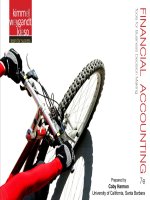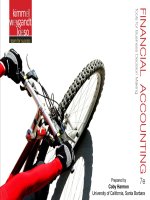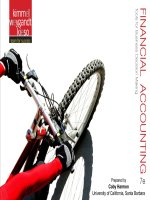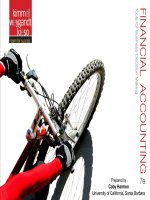Managerial accounting tool for business decision making chapter 10
Bạn đang xem bản rút gọn của tài liệu. Xem và tải ngay bản đầy đủ của tài liệu tại đây (2.13 MB, 75 trang )
Chapter
10-1
CHAPTER 10
BUDGETARY
CONTROL AND
RESPONSIBILIT
Y ACCOUNTING
Managerial Accounting, Fifth Edition
Chapter
10-2
Study
Study Objectives
Objectives
1.
Describe the concept of budgetary control.
2.
Evaluate the usefulness of static budget
reports.
3.
Explain the development of flexible budgets and
the usefulness of flexible budget reports.
4.
Describe the concept of responsibility
accounting.
5.
Indicate the features of responsibility reports
for cost centers.
Chapter
10-3
Study
Study Objectives
Objectives
6.
Identify the content of responsibility reports
for profit centers.
7.
Explain the basis and formula used in evaluating
performance in investment centers.
Chapter
10-4
Preview
Preview of
of Chapter
Chapter
Considers how budgets are used by management to
control operations.
Focuses on two aspects of management control:
Budgetary control, and
Responsibility accounting.
Chapter
10-5
Budgetary
Budgetary Control
Control and
and
Responsibility
Responsibility Accounting
Accounting
The
The Concept
Concept
of
of Budgetary
Budgetary
Control
Budget reports
Control activities
Reporting
systems
Static
Static Budget
Budget
Reports
Examples
Use and
limitations
Why flexible
budgets?
Development
Chapter
10-6
The
The Concept
Concept of
of
Responsibility
Responsibility
Accounting
Case study
Controllable vs
noncontrollable
Reporting
system
Flexible
Flexible
Budgets
Budgets
Reports
Managemen
t by
exception
Types
Types of
of
Responsibility
Responsibility
Centers
Cost centers
Profit centers
Investment
centers
Performance
evaluation
The
The Concept
Concept of
of Budgetary
Budgetary Control
Control
A major function of management is to control
operations.
Takes place by means of budget reports which
compare actual results with planned objectives.
Provides management with feedback on operations.
Budget reports can be prepared as frequently as
needed.
Analyze differences between actual and planned
results and determines causes.
Chapter
10-7
LO 1: Describe the concept of budgetary control.
The
The Concept
Concept of
of Budgetary
Budgetary Control
Control
Budgetary control involves the following activities:
Illustration 10-1
Chapter
10-8
LO 1: Describe the concept of budgetary control.
The
The Concept
Concept of
of Budgetary
Budgetary Control
Control
Works best when a company has a formalized
reporting system which:
Identifies the name of the budget report (such
as the sales budget or the manufacturing
overhead budget).
States the frequency of the report (such as
weekly or monthly).
Specifies the purpose of the report.
Indicates recipient of the report.
Chapter
10-9
LO 1: Describe the concept of budgetary control.
The
The Concept
Concept of
of Budgetary
Budgetary Control
Control
Illustrated below is a partial budgetary control system
for a manufacturing company.
Note the frequency of reports and their emphasis on
control.
Chapter
10-10
Illustration 10-2
LO 1: Describe the concept of budgetary control.
Review
Review Question
Question
Budgetary control involves all but one of the following:
a. Modifying future plans.
plans
b. Analyzing differences.
c.
Using static budgets.
d. Determining differences between actual and
planned results.
Chapter
10-11
LO 1: Describe the concept of budgetary control.
Static
Static Budget
Budget Reports
Reports
When used in budgetary control, each budget
included in the master budget is considered to be
static.
A static budget is a projection of budget data at
one level of activity.
Ignores data for different levels of activity.
Compares actual results with the budget data at
the activity level used in the master budget.
Chapter
10-12
LO 2: Evaluate the usefulness of static budget reports.
Static
Static Budget
Budget Reports:
Reports: Sales
Sales Budget
Budget
Example – Hayes Company
Budget and actual sales data for the Kitchen-mate
product for the first and second quarters of
2011 are:
Illustration 10-3
Chapter
10-13
LO 2: Evaluate the usefulness of static budget reports.
Static
Static Budget
Budget Reports:
Reports: Sales
Sales Budget
Budget
Example – Hayes Company, 1st Quarter
Illustration 10-4
Shows that sales are $1,000 under budget – an unfavorable
result.
Difference is less than 1% of budgeted sales - assume
immaterial (not significant) to top management with no
corrective action taken.
Chapter
10-14
LO 2: Evaluate the usefulness of static budget reports.
Static
Static Budget
Budget Reports:
Reports: Sales
Sales Budget
Budget
Example – Hayes Company, 2nd Quarter
Illustration 10-5
Shows that sales were $10,500, or 5%, below budget.
Material difference between budgeted and actual sales.
Merits investigation - begin by asking the sales manager the
cause(s) – consider corrective action.
Chapter
10-15
LO 2: Evaluate the usefulness of static budget reorts.
Static
Static Budget
Budget Reports
Reports –– Uses
Uses and
and Limitations
Limitations
Appropriate for evaluating a manager’s
effectiveness in controlling costs when:
Actual level of activity closely approximates the
master budget activity level.
Behavior of the costs is fixed in
response to changes in activity.
Appropriate for fixed costs.
Not appropriate for variable costs.
Chapter
10-16
LO 2: Evaluate the usefulness of static budget reports.
Review
Review Question
Question
A static budget is useful in controlling costs when
cost behavior is:
a. Mixed.
Mixed
b. Fixed.
c.
Variable.
d. Linear.
Chapter
10-17
LO 2: Evaluate the usefulness of static budget reports.
Flexible
Flexible Budgets
Budgets
Budgetary process more useful
if it is adaptable to changes in
operating conditions.
Projects budget data for
various levels of activity.
Essentially, a series of static
budgets at different activity
levels.
Can be prepared for each type
of budget in the master budget.
Chapter
10-18
LO 3:
Explain the development of flexible budgets and the
usefulness of flexible budget reports.
Flexible
Flexible Budgets
Budgets
Example – Barton Steel
Static budget for the Forging Department at a 10,000 unit level:
Illustration 10-6
Chapter
10-19
LO 3:
Explain the development of flexible budgets and the
usefulness of flexible budget reports.
Flexible
Flexible Budgets
Budgets
Example – Continued
Demand increases – produce 12,000 units rather than 10,000.
Illustration 10-7
Chapter
10-20
LO 3:
Explain the development of flexible budgets and the
usefulness of flexible budget reports.
Flexible
Flexible Budgets
Budgets
Example – Continued
Very large variances in budget report due to increased
demand for steel ingots.
Total unfavorable difference of $132,000 – 12% over
budget
Comparison based on budget data for 10,000 units - the
original activity level which is not relevant.
Meaningless to compare actual variable costs for 12,000
units with budgeted variable costs for 10,000 units.
Variable cost increase with production.
Budgeted variable amounts should increase
proportionately with production.
Chapter
10-21
LO 3:
Explain the development of flexible budgets and the
usefulness of flexible budget reports.
Flexible
Flexible Budgets
Budgets
Example – Continued
Budget data for variable costs at 10,000 units:
Illustration 10-8
Calculate variable costs at the 12,000 unit level:
Illustration 10-9
Chapter
10-22
LO 3:
Explain the development of flexible budgets and the
usefulness of flexible budget reports.
Flexible
Flexible Budgets
Budgets
Example – Continued:
New budget report (no change in fixed costs):
Illustration 10-10
Chapter
10-23
LO 3:
Explain the development of flexible budgets and the
usefulness of flexible budget reports.
Developing
Developing The
The Flexible
Flexible Budget
Budget
Steps:
1.
Identify the activity index and the relevant
range of activity.
2.
Identify the variable costs and determine the
budgeted variable cost per unit of activity for
each cost.
3.
Identify the fixed costs and determine the
budgeted amount for each cost.
4.
Prepare the budget for selected increments of
activity within the relevant range.
Chapter
10-24
LO 3:
Explain the development of flexible budgets and the
usefulness of flexible budget reports.
Developing
Developing The
The Flexible
Flexible Budget
Budget –– AA Case
Case Study
Study
Example – Fox Manufacturing Company
Monthly comparisons of actual and budgeted manufacturing
overhead costs for Finishing Department.
2011 master budget:
Expected operating capacity of 120,000 direct labor hours.
Overhead costs:
Illustration 10-11
Chapter
10-25
LO 3:
Explain the development of flexible budgets and the
usefulness of flexible budget reports.









